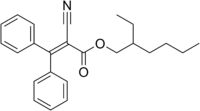- Octocrylene
-
Octocrylene  2-ethylhexyl 2-cyano-3,3-
2-ethylhexyl 2-cyano-3,3-
diphenyl-2-propenoateIdentifiers CAS number 6197-30-4 
PubChem 22571 ChemSpider 21165 
UNII 5A68WGF6WM 
ChEMBL CHEMBL1201147 
Jmol-3D images Image 1 - N#C/C(C(=O)OCC(CC)CCCC)=C(/c1ccccc1)c2ccccc2
- InChI=1S/C24H27NO2/c1-3-5-12-19(4-2)18-27-24(26)22(17-25)23(20-13-8-6-9-14-20)21-15-10-7-11-16-21/h6-11,13-16,19H,3-5,12,18H2,1-2H3

Key: FMJSMJQBSVNSBF-UHFFFAOYSA-N
InChI=1/C24H27NO2/c1-3-5-12-19(4-2)18-27-24(26)22(17-25)23(20-13-8-6-9-14-20)21-15-10-7-11-16-21/h6-11,13-16,19H,3-5,12,18H2,1-2H3
Key: FMJSMJQBSVNSBF-UHFFFAOYAD
Properties Molecular formula C24H27NO2 Molar mass 361.48 g/mol Density 1.05 g/cm3 Melting point 14 °C
Boiling point 218 °C at 1.5 mmHg
 (verify) (what is:
(verify) (what is:  /
/ ?)
?)
Except where noted otherwise, data are given for materials in their standard state (at 25 °C, 100 kPa)Infobox references Octocrylene is an organic compound used as an ingredient in sunscreens and cosmetics. It is an ester formed by the condensation of a diphenylcyanoacrylate with 2-ethylhexanol. It is a viscous, oily liquid that is clear and colorless.
The extended conjugation of the acrylate portion of the molecule absorbs UVB and short-wave UVA (ultraviolet) rays with wavelengths from 280 to 320 nm[1], protecting the skin from direct DNA damage. The ethylhexanol portion is a fatty alcohol, adding emollient and oil-like (water resistant) properties.
This organic compound can penetrate into the skin where it acts as a photosensitizer. This results in an increased production of free radicals under illumination.[2] Free radicals are known to induce indirect DNA damage and an increased concentration of free radicals might have contributed to the increased incidence of malignant melanoma in sunscreen-users compared to non-users (see Epidemiology of malignant melanoma)
See also
References
- ^ Smart Skin Care: Octocrylene
- ^ Hanson Kerry M.; Gratton Enrico; Bardeen Christopher J. (2006). "Sunscreen enhancement of UV-induced reactive oxygen species in the skin". Free Radical Biology and Medicine 41 (8): 1205–1212. doi:10.1016/j.freeradbiomed.2006.06.011. PMID 17015167.
Sunscreening agents approved by the US FDA or other agencies UVA filters UVB filters 4-Aminobenzoic acid (PABA) • Cinoxate • Ethylhexyl triazone (Uvinul T 150) • Homosalate • 4-Methylbenzylidene camphor (Parsol 5000) • Octyl methoxycinnamate (Octinoxate) • Octyl salicylate (Octisalate) • Padimate O (Escalol 507) • Phenylbenzimidazole sulfonic acid (Ensulizole) • Polysilicone-15 (Parsol SLX) • Trolamine salicylateUVA+UVB filters Bemotrizinol (Tinosorb S) • Benzophenones 1–12 • Dioxybenzone • Drometrizole trisiloxane (Mexoryl XL) • Iscotrizinol (Uvasorb HEB) • Octocrylene • Oxybenzone (Eusolex 4360) • Sulisobenzone • hybrid (chemical/physical): Bisoctrizole (Tinosorb M) • physical: Titanium dioxide, Zinc oxideCategories:- Carboxylate esters
- Household chemicals
- Sunscreening agents
- Nitriles
Wikimedia Foundation. 2010.
